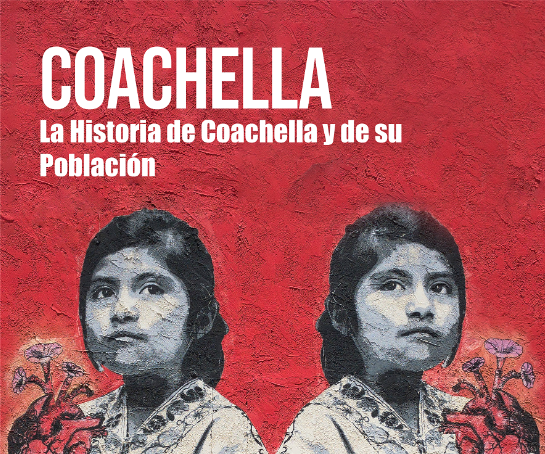

News from: the City of Coachella
A History of Coachella and its People highlights the people who supplied most of the labor needed to develop the Coachella Valley’s agriculture industry during the past 120 years, including the Cahuilla Indians, immigrants from Japan and Mexico, and African Americans fleeing persecution in the South.
The book documents the achievements as well as the racism and discrimination suffered by non-white ethnic groups while highlighting how several eastern Coachella Valley immigrant children have used higher education as a pathway to pursue their dreams and to help their communities.
Coachella has always been a city of immigrants who have provided the labor needed to fuel the growth of the Coachella Valley’s agriculture and tourism industries.
But the critical roles that immigrants to Coachella and other East Valley communities have played in the development of the Coachella Valley economy and the experiences they have had here have seldom been the focus of history books, which generally have focused on Palm Springs and on the valley’s emergence as a “playground of presidents” and the Hollywood elite.
That changed when the city commissioned a book of its own, A History of Coachella and its People, which is now available in English and Spanish for $14.99 in print and for free online at coachella.org as a public service.
The 110-page book documents interesting and little known aspects of the eastern Coachella Valley’s immigrant history and the roles that immigrants and migrants from other states have played in the development of Coachella and the eastern Coachella Valley.
“We felt it was important that the people of Coachella have a book of their own, one that focuses on their own community and their own history and that of the eastern Coachella Valley during the past 120 years,” said Mayor Steven Hernandez. “This book provides important and little known information about our local history that previously was not easily accessible in print or online.”
“The book documents various forms of discrimination that immigrants and African Americans have endured here that are often not presented in U.S. history books,” said Councilwoman Megan Beaman-Jacinto, who specializes in civil rights law.
The book also documents the rise of Latino politicians and highlights the critical need for the children of immigrants to do well in school and to pursue a college education if they want to improve their own economic opportunities and make additional positive contributions to their communities. The book provides striking examples of several East Valley children of immigrants who are currently pursuing or have already achieved careers in healthcare and in government by focusing on their education.
“Each of these young children of immigrants are convinced that anyone, really, can change their circumstances if they work hard in school, make use of mentors, and seize opportunities for education, internships and work that come their way,” said Councilwoman Josie Gonzalez, adding, “In the final analysis, education is key to building and creating new opportunities in life. That’s one message we hope comes through with this book.”
“It reads easily and yet it is packed with information, which I would guess is not known to most of the people in the Coachella Valley,” said Laura Ahmed, an English instructor at College of the Desert in Palm Desert who was previously principal of Palo Verde High School, assistant principal of Redlands East Valley High School and a teacher for many years.
“As an educator,” Ahmed said, A History of Coachella and its People is a book that is multidimensional, and a great educational tool. It not only has historical relevance. It is thought provoking and an excellent example of research methodology. Reading it will spark great discussions across the curriculum, inspire original thoughts and put a fresh perspective on racial discrimination.”
The Palm Springs Historical Society published a book in 2005 titled, We Were Here Too: The History and Contributions of the Original Mexican Families to the Palm Springs Village. But aside from a self-published book titled Coachella Valley Mexican American Pioneer Roots, which was produced by the Mexican American Pioneers in December 2009, and a commemorative yearbook, Coachella Valley Union High School: The First 50 Years 1910-1960, relatively little has been written about the immigrant history of Coachella and the eastern Coachella Valley.
A History of Coachella and its People builds on these earlier research efforts and provides a well documented history of Coachella and the eastern Coachella Valley. The book is designed to provide an introduction to Coachella and eastern Coachella Valley history.
Researched and written by Jeff Crider, a former Desert Sun and Press-Enterprise reporter, the book includes many direct quotes from heretofore unpublished accounts of the children of the valley’s Mexican American pioneers who were interviewed in 2007 by Dr. Sarah McCormick-Seekatz as part of an oral history project organized by the Coachella Valley History Museum and Cultural Center in Indio.
Dr. McCormick-Seekatz is one of a handful of historians who have taken an interest in researching various aspects of the Coachella Valley’s immigrant history.
Crider also interviewed the children and grandchildren of several of the eastern Coachella Valley’s Mexican American, Japanese American and African American pioneers in addition to incorporating information they presented in public displays during the March 17, 2018 Heritage Festival at the Coachella Valley History Museum.
Crider also conducted additional historical research using the valley’s oldest newspapers, such as the Coachella Valley Submarine and The Date Palm as well as The Desert Sun, the Los Angeles Times and other sources, including history books and scholarly articles.
Crider worked closely with several mentors with expertise in eastern Coachella Valley history, including Dr. McCormick-Seekatz, Ray Torres of the Coachella Valley Mexican American Pioneers, and the late Louise Rodarte Neeley, herself a well known daughter of one of the valley’s pioneering families who served as chairman of the La Quinta Historical Society and worked with other local historical societies for many years.
A History of Coachella and its People documents little known aspects of eastern Coachella Valley history.
The book notes, for example, that eastern Coachella Valley immigrants and their families worked in every industry, including the valley’s first hotels and restaurants. They fought alongside U.S. troops in World Wars I and II, in Korea, Vietnam as well as Iraq and Afghanistan. Many distinguished themselves with their service.
“The successes and perseverance of eastern Coachella Valley immigrants and their families are particularly noteworthy given the many periods of economic, social and political discrimination they have had to endure and overcome at various times during the past 120 years,” Beaman-Jacinto said.
Local discriminatory practices included laws preventing Japanese and African Americans from owning private property, the segregation of Mexican American schoolchildren, and even the segregation of local cemeteries. Many of these discriminatory practices were common across the United States during the early 20th century.
Many immigrants who came to the eastern Coachella Valley from Mexico during the first half of the 20th century were segregated by classroom or placed into separate schools distinct from anglo students, according to Mexican American pioneer families interviewed by Dr. McCormick-Seekatz. The practice of segregating Mexican American students in California did not end until after a U.S. District Court ruling in 1946, which found that segregating Mexican American students violated the 14th Amendment of the U.S. Constitution. The case was a precursor to the U.S. Supreme Court’s 1954 Brown vs. Board of Education decision, which made it illegal to segregate black and white students across the country.
The eastern Coachella Valley’s Mexican immigrants and U.S.-born citizens of Mexican descent also suffered economic and political discrimination throughout much of the Great Depression because of concerns they were taking away jobs from anglo workers. Between 400,000 and more than 1 million Mexican and Mexican-American workers and their families were deported to Mexico between 1929 and 1934 in a dark and seldom talked about chapter of American history called the “Mexican Repatriation,” a topic that is also explored in the book.
While anglos feared job competition from Mexican immigrants during the Great Depression, growers in the Coachella Valley and across the country were desperate for their help during World War II, when many of America’s able-bodied men were sent to fight overseas. The federal government’s enactment of the Bracero Program on Aug. 4, 1942 helped to ensure that growers could offset World War II-related farm labor shortages by importing temporary guest laborers from Mexico. The Bracero Program continued until 1964.
“Even as immigrant families from Coachella and the eastern Coachella Valley endured the ups and downs of anti-immigrant sentiment in the Coachella Valley and across the country, many of them prospered, starting their own ranches and other businesses and building the sense of community that we have today,” Gonzalez said.
A History of Coachella and its People also documents the participation and involvement of Mexican and Filipino farmworkers in strikes and table grape boycotts organized by Cesar Chavez and the UFW beginning in the late 1960s.
The city of Coachella released an initial printing of the book in October during Mayor Hernandez’s State of the City Address. The city plans to make the book available to public
and university libraries and hope that local high school and college professors across the Coachella Valley will use it as a teaching resource.
Several universities across the country have already requested A History of Coachella and its People for their library collections, including California State University, San Bernardino; the University of California, Riverside; the University of Texas at Austin; Harvard University; Duke University; Tuskegee University; and Howard University. The Chicano Research Project in Stockton has also requested the book.
Coachella residents who have historical information and photos they think should be considered for future editions of the book are encouraged to contact Jacob Alvarez at jalvarez@coachella.org. Those wishing to order copies of the book should also email their request to Mr. Alvarez.
Comments are closed.

